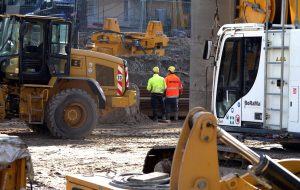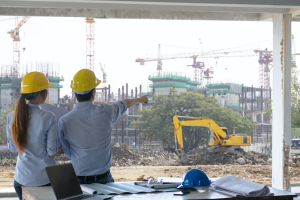
5 Critical First Steps to Build a Construction Business
When you want to build a construction business, the steps are similar to those of any other type of company. Of course, there are details that need to be changed, but the first steps are a foundation for any type of company, from market research to securing the funds you need. Registering a Formal Business Business registration is often the first step to being formally recognised. It also places you on the official register for paying taxes and accessing any benefits that come with it. When you register a company with Companies House (UK), for example, it makes the business an entity. However, that means you must also become compliant. So make sure you choose the proper business structure, such as LLC, obtain the licences you need and acquire relevant insurance. Market Research and Niche Definition One of the most overlooked parts of starting a new business is market research. It’s great to have an idea, but that idea might not align with what customers want, so securing business becomes a challenge. Identifying a need and filling it is a major advantage, such as paving services. However, a niche can help your business surpass some competitors by capitalising on a specific need. For example, installing concrete garage floors with an epoxy resin coating. Build a Construction Business with a Plan It is widely believed that over 90% of new businesses fail within the first year. One of the most common reasons for failure is cited as not having an adequate business plan. Of course,operating a successful construction business depends on much more than a plan, but a plan will ensure you build a solid foundation and get off to the best possible start. It helps to include the structure and management team, the services you will offer and detailed financial projections. Securing the Necessary Funding Of course, any business needs funding to start. In construction, new companies typically have a very high startup cost. This is because you need funds for labour, materials and equipment, many of which can be very expensive. As part of your plan, identify accurate costs you can show a lender, like a bank or an investor. You can also secure funding by showing anyone involved accurate projections and the expected time before making a profit for repayment. Finding and Building the Right Team No reliable business operates on luck and prayers. When it comes to something as complex as construction, the right team is critical. Hiring skilled workers who are trained, competent and know what they are doing is an essential first step. However, you will also need to network with suppliers for favourable deals and terms. However, a new business needs to build a solid reputation too. In construction, necessary safety and training, such as OSHA, is an advantage. Summary Registering your company is one of the most important first steps to building a construction business. Of course, a detailed plan will help you get off to a good start. However, any business also relies upon a well-trained, competent and dedicated team when getting off the ground.

What to Look for When Comparing Home Builders Today
The decision to build a home is one of life’s most significant investments. With the financial stakes and personal implications so high, the choice of a builder can be the difference between a dream realized and a stressful ordeal. In today’s dynamic construction market, savvy comparisons must go beyond simple price checks. The process should involve a thorough evaluation of reputation, expertise, business practices, and long-term reliability. Here’s what to look for when comparing home builders today. Verifying Builder Credentials, Stability, and Reputation A builder’s credentials and reputation form the bedrock of any sound hiring decision. Financial stability has emerged as a critical priority, with the recent collapses of several new home construction companies underscoring the risks involved. Homeowners should inquire about a builder’s longevity, as it typically correlates with financial health and the ability to honor future warranty claims. Below are some factors to consider: Lastly, prospective homeowners can start their search with local industry directories and resources like https://www.service.com.au/find/builders/perth-wa, which can provide an initial list of local professionals. Assessing Quality, Specialization, and Style Alignment The true measure of a builder is the quality of their finished product. Specialization also matters as a builder’s adept at constructing first-home owner projects may not have the expertise for a complex, luxury custom home. For instance, a portfolio of completed projects is a good start, but a physical inspection is far more revealing. Homeowners should ask to visit completed homes to inspect the quality of finishes, cabinetry, trim work, and paint. For a project like a luxury custom home, choosing a builder with a proven local track record in that specific niche is crucial. Furthermore, it’s essential to understand what a builder’s standard quote includes and the flexibility they offer for customization. Some builders work from fixed design selections with limited variations, while others, particularly custom builders, offer a collaborative design process. Clarifying these parameters upfront can help prevent misunderstandings and ensure the builder’s capabilities align with the homeowner’s vision. Understanding Contracts, Communication, and Project Management The contractual and working relationship defines the building experience. A clear, detailed contract and a compatible communication style are vital for a smooth process. Below are some things to consider: Understanding these factors can help homeowners compare home builders more effectively. Evaluating Costs, Timelines, and Value While budget is a primary concern, the cheapest quote is rarely the best value. A comprehensive comparison must consider what is included, the quality of materials, and the builder’s track record for on-time completion. Here are some things to keep in mind: Beyond the Base Price When comparing quotes during the homebuying process, it is imperative to ensure they are for identical scopes of work, including the same floor plans and specified building materials. This precise comparison is a crucial step in the current housing market, where clarity prevents future financial strain. Many first-time builders underestimate the full budget by overlooking site costs, landscaping, fencing, and utility connection fees. A realistic budget, foundational to a sound homebuying process, should include a contingency buffer of approximately 15-20% for unexpected expenses, especially given fluctuating costs for labor and building materials. Realistic Scheduling and Location Expertise Builders should provide a clear estimated timeline for completion. Furthermore, a builder’s experience in a specific geographic area can be a significant advantage. Local home builders are familiar with council regulations, soil conditions, and have established relationships with local suppliers and subcontractors, which can help mitigate delays and control costs. Key Takeaway Comparing home builders today requires a multifaceted approach that balances objective due diligence with subjective assessment of trust and compatibility. By keeping the information mentioned above in mind, homeowners can make an informed choice. This diligent process can transform the selection from a daunting task into a foundational step toward a successful and satisfying home-building journey.

How Web3 Finance Tools Could Reshape Construction Capital Flows
Construction is one industry that has never lacked ambition, but its financial systems often struggle to keep up. It’s common for money to move through lenders, consultants, insurers, and project managers. Weeks have passed by the time funds reach suppliers or contractors. This lag creates tension on-site and pressure in the office. Smaller firms feel it most, especially when they are expected to front labour and materials. It’s this financial environment that has led to Web3 finance tools being discussed less as an experiment and more as a response to problems the industry already knows too well. What Other Industries Already Do Well It’s understandable for construction firms to be skeptical about blockchain finance. After all, the sector is well-known for being cautious (and for good reasons). Yet, similar tools are already doing heavy lifting in other industries. Global logistics firms use blockchain systems to manage complex payment chains across borders. Energy markets rely on them to settle frequent, high-value trades between multiple parties. Online casinos offer a clear example of blockchain working at speed. Many of these platforms handle frequent deposits, withdrawals, bonuses, and payouts across diverse cryptocurrencies, and players expect everything to clear quickly and accurately. As a result, decentralised wallets and near-instant crypto payments sit at the core of how these platforms move money every day as essential systems (source:https://casinobeats.com/uk/online-casinos/bitcoin-casinos/). In all of these sectors, systems operate under pressure, where errors cost money and trust. That track record matters when considering whether the technology can hold up in construction. Tokenised Funding and Earlier Access to Capital Tokenised funding offers a different way to raise money for construction projects. Instead of relying solely on banks or private lenders, developers can issue digital tokens linked to future income or ownership rights. This allows investment to come from a broader base and at an earlier stage. For contractors, that matters. Payments can be structured around delivery points rather than delayed approvals. Investors also gain flexibility, as tokens can be held or transferred depending on appetite for risk. The appeal here is not novelty. It is timing, visibility, and a funding structure that better reflects how projects actually progress. Smart Contracts on Live Projects Smart contracts are often described in technical terms, but their impact in construction is straightforward. They release money when agreed conditions are met. A completed inspection, signed delivery note, or verified milestone can trigger payment without further chasing. This reduces disputes and cuts out long approval chains. Subcontractors are paid sooner, which helps with staffing and supplier relationships. Project owners retain control, since funds only move when conditions are satisfied. There are legal details to address, but on active projects, the benefit is less paperwork, minimised errors, less administrative costs, and fewer arguments about when money should move. New Approaches to Credit and Lending Credit remains a sticking point across the construction industry. Many capable firms struggle to access finance because traditional assessments fail to reflect how construction work is delivered. Web3 lending platforms use on-chain records such as verified contracts, performance history, and tokenised assets to assess risk. Borrowing terms can change as a project develops rather than being fixed at the start. This does not remove risk, but it makes it more visible to both sides. For smaller contractors in particular, it offers an option beyond long waits and inflexible terms. Shared Decision Making Through Decentralised Structures Decentralised investment groups also introduce a different way to manage funding decisions. Through blockchain-based governance, multiple stakeholders can contribute capital and vote on how it is allocated. In construction, this use of blockchain could suit regeneration schemes or developments with mixed public and private interests. Voting records and spending decisions remain open to review. That visibility does not guarantee agreement, but it does reduce confusion about who approved what. For projects that rely on collaboration rather than a single dominant funder, this approach deserves attention. Yet, none of this removes the need for caution. UK regulation continues to develop. The Building Safety Act is evidence of this, which is why construction firms must work within existing procurement and financial rules. Integrating new tools with established accounting systems takes time. Conclusion Web3 finance tools are not a cure-all, but they can address daily construction pain points. Slow payments, limited access to capital, and low transparency disrupt sites and supply chains. Tokenised funding, automated payments, and alternative lending can ease those pressures. Adoption will be gradual, but the conversation has moved beyond theory. For an industry that runs on cash flow as much as concrete, that matters.

Finning urges sites to update cold weather plans to avoid costly power downtime
Site managers are being urged to ensure power systems are serviced and back-up plans put in place, as forecasters predict a cold winter ahead. The Power Systems team at Finning UK & Ireland is advising facilities managers to shore up their contingency operations to protect against costly downtime caused by any future outages. Engine cold starts, increased friction, fuel gelling, and low battery outputs can all cause significant generator damage if left unaddressed. According to the Royal Meteorological Society, last winter Storm Darragh (December 2024) caused 2.3 million power cuts. And long-range forecasts for early 2026 are showing a likelihood of a colder and drier than average winter. With significant financial and functional impact at stake for businesses across sectors such as healthcare, digital infrastructure and manufacturing, establishing good generator health going into the winter months is crucial to protecting continued operations. Finning said it is never too early to prepare for blackouts and power cuts, as the cold weather puts additional pressure on an already fragile electricity grid. Rob Froome, Head of Project Delivery Contracts & Commissioning at Finning, said: “Whether it’s data centres, construction sites or hospitals, we know the cold weather will be a problem for site managers across the board. The key is to determine your power requirements, whether you plan to provide power for the entire facility or for critical load only, and then implement a temporary power solution that is tried and tested before you need it. “We know that engine wear is highest during a cold startup, with it typically associated with around 70% of engine wear. Running generators cold means increased stress on the system leading to a shorter lifespan. Generator maintenance, servicing, and planning for lower temperature use will help elongate the life of components and help to burn fuel more efficiently during these conditions.” Emergency planning is another key aspect to winter weather preparation. Having clear operational steps for loss of power will help reduce downtime. Finning Power Rental can help to prepare backup power options or provide quick response in the event of an emergency to implement backup power. Rob added: “Having the right equipment, the right emergency contacts, and a plan for fuelling is critical for cold weather running. Don’t wait for the inevitable to happen because by then it’s too late, the damage is done. Increased costs from longer downtimes and fuel usage, as well as generator damage, result from a lack of planning and maintenance. Prepare for the worst now and expect the best later.” A planning document to assist site managers is available to download by visiting: https://www.cat.com/en_US/by-industry/electric-power/electric-power-industries/rental-power/disaster-preparedness-article.html Building, Design & Construction Magazine | The Choice of Industry Professionals

Choosing the Right Shower Tray Sizes for Your Bathroom
Selecting the right shower tray sizes is a crucial step in designing a functional and comfortable bathroom. A well-chosen tray not only complements the shower enclosure but also ensures optimal use of the shower space and fits seamlessly with the bathroom’s size. Understanding Standard and Popular Tray Sizes Most homeowners start with standard shower tray sizes, which are designed to suit typical bathroom layouts. Rectangular shower trays and square shower trays are the most common, providing a reliable solution for larger bathrooms and smaller rooms alike. For those seeking space saving options, quadrant shower trays and offset quadrant shower trays can fit neatly into corners, allowing for more room in compact layouts. When considering different shower tray sizes, think about both the tray height and the waste position. Low profile options such as low profile shower trays are ideal for creating a walk in shower or wet room with easy access, while stone resin or acrylic trays provide durability and style. For example, a 1200 x 1000 shower tray is a popular choice for a spacious rectangular layout. This size can fit perfectly in many bathrooms while providing ample space to move comfortably. You can find options like this on our website that cater to modern bathroom designs. Rectangular and Square Trays Rectangular trays are ideal for rectangular showers and walk in showers, offering a perfect shower base that makes the shower area feel larger. Square trays suit square showers and are often chosen for small bathrooms, where space is limited but comfort remains a priority. If you have a larger bathroom, a shower tray 1600 x 900 provides ample space and allows the installation of a shower door that opens freely without obstructing the bathroom floor. Quadrant and Offset Quadrant Options For corner installations, quadrant shower trays and offset quadrant trays offer space saving designs without compromising access or comfort. These trays suit smaller rooms perfectly and allow for walk in layouts. Offset quadrant trays are especially useful when you need a shower enclosure to fit perfectly against angled walls or obstacles. Low Profile and Walk-In Solutions Modern low profile shower trays are a key feature in wet rooms. They provide a small lip, making the floor nearly continuous and enabling easy access for everyone, including children and the elderly. Coupled with riser kits, these trays can align with waste pipes for seamless drainage. Walk in shower trays enhance the shower area, giving a sense of spaciousness and fluidity in your bathroom designs. Choosing the Ideal Shower Tray Size When selecting the ideal shower tray size, consider your shower space, shower door swing, and the position of the shower waste. A large shower tray is suitable for larger bathrooms, while smaller trays or square trays work in smaller rooms. Tray height is another important consideration, as low profile trays improve access, and higher trays can hide pipework effectively. Think about your bathroom layout and shapes. Rectangular trays suit elongated spaces, while quadrant shaped shower trays fit neatly in corners. Different shapes offer flexibility, allowing your walk in shower or shower enclosure to suit your room without wasting space. Practical Tips for Installation By planning carefully, you can ensure that most shower trays in your selection will fit perfectly, provide a perfect shower base, and complement your bathroom’s size and style. Shower tray sizes are not just measurements—they impact comfort, access, and the overall spatial experience in your bathroom. Final Considerations In conclusion, selecting the right shower tray sizes is an essential part of bathroom design. Whether you opt for rectangular trays, square trays, quadrant or offset quadrant options, there are plenty of popular sizes that meet both functional and aesthetic needs. Modern low profile and walk in shower trays improve access and enhance the spacious feel of your bathroom. Choosing a shower tray from a trusted source, like Wet Rooms Design, ensures you have access to various sizes, shapes, and materials suitable for all bathroom designs. With careful measurement and consideration of tray height, waste position, and shower space, your shower enclosure will look great and function perfectly for years to come. Maximizing Space and Comfort When planning your shower area, think about how your shower tray sizes affect movement and access. A well-chosen ideal shower tray provides ample space without overcrowding the bathroom floor. Rectangular trays can create a spacious rectangular feel, while square trays work well in smaller rooms. For walk in setups, a low profile tray with a small lip enhances safety and convenience. Always consider the shower door swing and tray height to ensure your shower enclosure feels open and comfortable. Proper planning with different shapes and tray sizes allows your bathroom to fit perfectly while maintaining a clean, modern look.

Why Competency Standards Matter in Today’s Construction Industry
Construction demands precision. One error can cost time, money, or lives. There’s no room for uncertainty on-site. Each task must be done by someone who knows exactly what they’re doing. Skill alone isn’t enough. Proof matters. Competency standards make that proof clear. They show who’s qualified, who’s trained, and who can be trusted with critical work. These standards aren’t rules for the sake of control. They exist because the work is too important to leave to chance. Every role affects the one next to it. When everyone meets the same benchmark, the whole site runs tighter, faster, and safer. Strengthen Construction Site Safety One mistake can cost a life. Faulty wiring, poor lifting technique, or a missed hazard often trace back to unqualified workers. Competency standards stop this before it starts. When expectations are consistent, everyone knows what to do. Workers follow proven steps. Supervisors spot issues early. The construction site becomes safer because no one guesses. Experience helps, but it can’t speak for itself. Standards test the ability to act under pressure. They confirm who’s ready to work without hesitation or hand-holding. On a live site, safety needs structure. Competency provides it. That structure saves time, avoids injury, and protects every trade on-site. Build Trust Across the Site Workflows break when skills don’t match the job. One weak link slows everyone else down. It’s not enough to say someone’s qualified. Teams need to see it. They need proof that every worker can do the task without second-guessing. That’s where verified competency steps in. It takes away doubt. It gives employers a clear picture of what someone can handle. When workers show up with recognised credentials, they walk in ready. That readiness shapes how fast projects move and how well teams collaborate. The CSCS Blue card, for example, helps confirm that a worker’s training and experience meet industry standards. It clears access, reduces delays, and sets the tone for the rest of the crew. Workers know where they stand. In fast-paced builds, no one has time to check assumptions. Verified skills give structure to that pace. They show who’s ready and who still needs development. Create Consistency Across Sites and Teams Construction rarely happens in isolation. Sites involve multiple trades, subcontractors, and rotating crews. Without shared benchmarks, instructions get misread, timelines shift, and quality suffers. Standards prevent that. They bring everyone to the same baseline. A welder in Manchester follows the same criteria as one in Birmingham. Supervisors know what to expect. Worker training doesn’t need to start from scratch every time a new team joins. This consistency speeds up onboarding and keeps work aligned. It reduces the friction caused by mismatched methods or unclear expectations. Everyone speaks the same technical language from day one. When crews change, the workflow shouldn’t. Competency standards help projects maintain pace and integrity, regardless of who’s on-site. They protect progress by ensuring every worker fits into the system without confusion. Reinforce Accountability on the Job Clear roles require clear skills. When something goes wrong, teams need to trace the issue quickly. Without verified standards, responsibility becomes a guessing game. That delay can cost more than time. Competency frameworks link tasks to qualifications. They show who was trained to do what. If an error occurs, it’s easier to spot the cause and fix it fast. It also highlights where retraining may be needed before the next phase begins. This structure helps contractors manage risk. It supports documentation, protects against claims, and proves compliance. It also shows clients that quality control isn’t optional. Strong projects rely on ownership. Standards reinforce that by making expectations public and traceable. Each person is answerable for the work they’re trained to do. That clarity pushes performance forward. Support Career Progression Construction workers don’t enter the industry to stay in one spot. Many aim to lead teams, manage sites, or specialise in higher-level trades. But ambition alone isn’t enough. Progress requires proof of skill that employers recognise across projects. Competency standards provide that path. They outline what’s needed to move from one role to the next. Each qualification adds to the worker’s toolkit. That growth builds confidence, both for the worker and the team relying on them. For younger workers and apprentices, these benchmarks show that hard work pays off. They turn experience into opportunity. Supervisors can spot talent earlier, knowing the next step is clear and achievable. In a workforce built on skill, progression needs structure. Standards bring fairness to that process. They reward learning, reduce bias, and make advancement a matter of readiness, not who you know. Skilled Work Protects Project Quality and Investment Every detail on-site affects the final result. Weak workmanship leads to cracks, leaks, delays, and cost overruns. Small errors often require large repairs. When teams cut corners on skill, the structure pays the price. Competency standards reduce those risks. They ensure that workers meet a defined level before taking on tasks that impact the build. That preparation improves accuracy. It also helps crews work faster with fewer mistakes. Clients rely on quality that lasts. Projects built by qualified teams hold their value longer. They meet codes, pass inspections, and require less corrective work later on. Skilled work builds confidence. That starts with verified standards. When everyone knows what’s expected, projects move with fewer surprises. Outcomes improve. So does the reputation of everyone involved. Future Demands Will Rely on Proven Competency Construction isn’t standing still. New materials, digital tools, and stricter regulations push the industry forward. Meeting those demands requires more than experience. It calls for verified, up-to-date skills. As projects grow more complex, standards keep teams aligned. They help workers adapt to change without losing pace. From automated equipment to sustainable builds, every shift needs people who can prove they’re ready. Clients and regulators want transparency. They expect records, not word-of-mouth. Competency frameworks deliver that proof. They show that workers are trained for today and prepared for what’s next. The industry keeps evolving. Sites that rely on formal standards won’t fall behind. They’ll lead.

